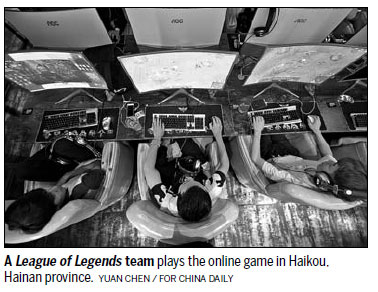Look to the movies, experts tell games developers at forum
Games developers can use copyright to protect their created games images - just like movies - because games consist of images, words and stories like movies, experts told a recent forum held by the University of Chinese Academy of Social Sciences.
The games industry is one of the most lucrative sectors in China, expected to rake in revenue of nearly 220 billion yuan ($33.6 billion) this year, ranking second among cultural industries only behind the film and TV industry, according to a report released by the China Culture & Entertainment Industry Association last month.
Online games have contributed significantly to the industry, with estimated total revenue this year projected at about 201 billion yuan, the report said.
Online livestreaming websites and apps, creating realtime broadcasts and commentary platforms for games players, have promoted the rapid development of the gaming industry.
Players can communicate with others on the broadcast platforms, and top games players can get rewards, designed to help sustain development of the games sector.

As a result, IP rights and unfair competition problems, which are related to the live broadcasts of online games, have increasingly emerged.
That, in turn, has led to many disputes.
Fu Gang, deputy director of the Shanghai Bar Association, told the forum that images that appear in livestreaming for an extended time are integral to the production, instead of being incidental use.
"Although the images are only part of the content of the online game, it is still a piece of work and an indispensable part of the game," he said.
"A reproduction of a live game should be identified as copyright infringement."
In fact, copyright law does not have an agreed position on online games and opinions are mixed among jurists.
Some believe images from an online game do not have independent copyright, because their use is inevitable during livestreaming.
They say that in movies and TV, there are often a large number of other creative works depicted incidentally for filming needs. These include paintings, calligraphy and sculptures, and as long as those images are used to serve the story, their use should not be regarded as infringement.
They argue that the same applies to games pictures in a live broadcast.
Fu, however, said that after studying legal cases at home and aboard, courts recognized that some games with storytelling could constitute cinematic work. This, he said, demonstrated that judicial practice recognized the aesthetic value of games.
Therefore, pictures in games should be given similar protection, Fu added.
Jurists also suggested that other elements, such as maps, should be equally protected under copyright law.
Sun Lei, a judge at the Beijing's First Intermediate People's Court, said that copying a game's map, was actually plagiarism of the game. This was because the design of a map represented intellectual work, and a valuable map needed to be protected.
Wu Yixing, a partner of Dare and Sure Law Firm in Beijing, suggested that copyright law mainly aim at providing protection for fine works or graphic works. However, the art and the function of valuable games maps are indispensable. Therefore, protecting games maps, as important elements of the work, can be used as a feasible way to protect games.
hanlu@chinadaily.com.cn

(China Daily 12/14/2017 page17)














